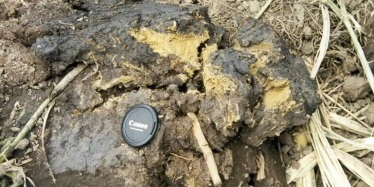|
|
Acid sulfate soilsAcid sulfate soils are saturated with water and contain iron sulfides. The conditions required to form acid sulfate soils are often found in wetlands, particularly in coastal areas, but they can even occur in the arid zone. When acid sulfate soils are disturbed, they can generate large amounts of sulfuric acid, iron, aluminium and sometimes heavy metals. The soil pH drops from nearly neutral to extremely acidic, often below pH 2[1]. This can cause major impacts to the environment, human health and infrastructure. Guidance material in Queensland for the identification and management of acid sulfate soils can be found at: Acid sulfate soils Quick facts
Acid sulfate soils contain microscopic crystals of iron sulfide, and contain almost no oxygen[1]. They are usually formed in organic rich and anoxic (e.g. oxygen-free) environments when microbes reduce sulfate to sulfide. Sulfide then combines with ferrous ion (Fe2+) to precipitate iron sulfide minerals (such as FeS2 or pyrite), at the same time producing bicarbonate ions as a by-product. This pyrite remains stable if maintained in oxygen-free conditions, but represents a potential source of acidity if allowed to oxidise (since the bicarbonate produced during their formation becomes separated from the soil, and is no longer present to neutralise any acid produced from sulfide oxidation). Unlike the pyrite found in other areas, the crystals of pyrite formed in acid sulfate soil environments are microscopic, often assembled into larger raspberry-shaped structures known as framboids. This ‘framboidal’ pyrite has a large effective surface area, meaning that when these soils are exposed to oxygen, either through excavation or drainage works that lower the soil’s water table, they oxidise very rapidly. This oxidation reaction produces significant quantities of sulfuric acid and is the most acidic weathering reaction known at the earth’s surface. When acid sulfate soils are undisturbed, they are usually dark blue-grey (sometimes black) and wet. They can have a high clay content, but can also form in sands, gravels, or peats. When disturbed, the iron released from the pyrite oxidation forms a range of brightly coloured minerals, which are first yellow, then brown, then red. Cracks open up on the soil surface, and the soil shrinks as it dries out. Links and referencesVersion 5 of Queensland Acid Sulfate Soil Technical Manual, Soil Management Guidelines References
Last updated: 18 October 2023 This page should be cited as: Department of Environment, Science and Innovation, Queensland (2023) Acid sulfate soils, WetlandInfo website, accessed 8 May 2025. Available at: https://wetlandinfo.des.qld.gov.au/wetlands/ecology/components/substrate/soils/acid-sulfate-soils/ |

 — Department of the Environment, Tourism, Science and Innovation
— Department of the Environment, Tourism, Science and Innovation


